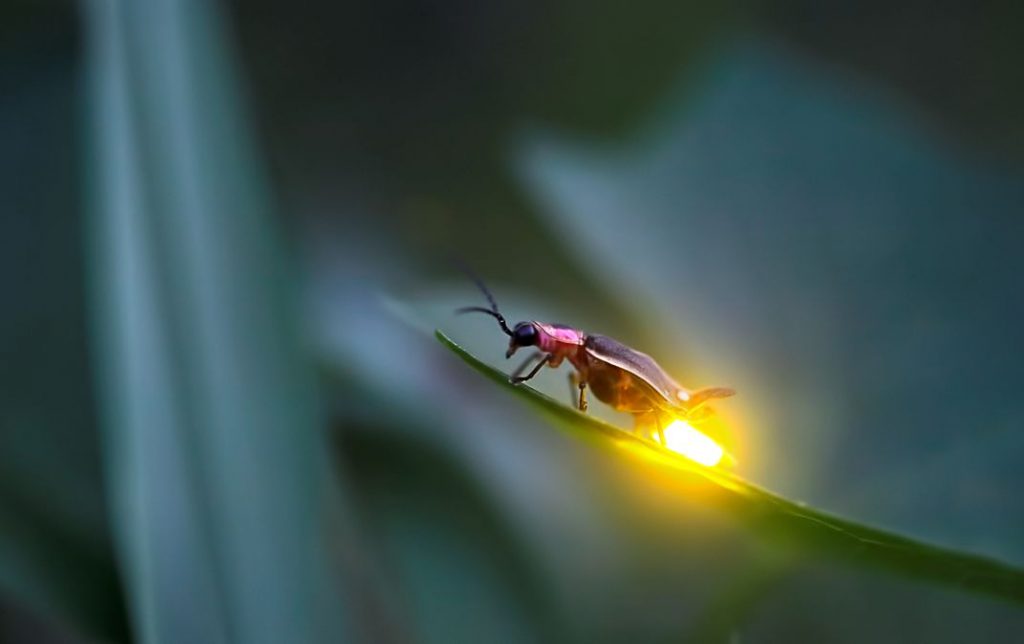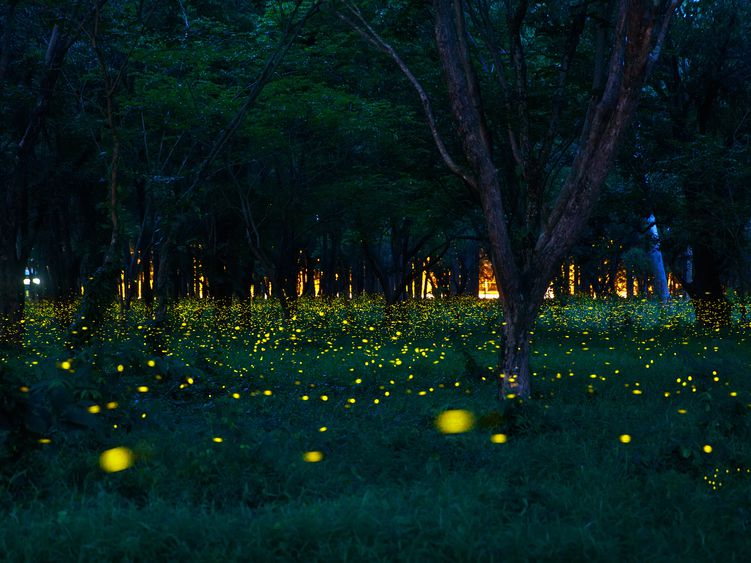Plants And Insects that Glow’s at Night

Do you ever wonder what’s going on in your garden or at the park when you are comfortable in bed? What do plants and animals do once the sun goes down and the day time predators head home?
As the darkness covers the atmosphere, there are a different set of workers that nature has employed and they have the unique adaptations that allow them to function at night.
One of the most astonishing adaptation that plants and insects have is bioluminescence.
Bioluminescence is a phenomenon when organisms produce and emit light. The light is commonly produced due to a chemical reaction between different type of luciferin and oxygen.
These wondrous properties are a common trait among plenty of marine organisms like bacteria, algae, worms, crustaceans, starfishes, sharks, and terrestrial organisms like fungi and insects naturally.
Which Plants glow’s in the dark?
Bio-luminescence is quite rare in true plants compared to animals. Usually, a plant appears to light up at night because of bioluminescent bacteria or other microorganisms living on it.
Although rare, there are a bunch of terrestrial plants that glow on their own. These plants are mostly fungi and a plant-like species called Dino flagellates.
Bio-luminescence Fungi – These glowing mushrooms like fungus are usually found in the temperate and tropical climate.
There are about 75 total species of at night glowing fungi recorded as of now and most of these species fall under the subcategory of Basidiomycetes with an exception of one Ascomycete.
These plants emit a greenish light at a wavelength of 520nm and occur in the fruiting body as well as in Mycelia.
Dinoflagellates – These plant-like Protists are a unicellular organism that has two flagella and lives in the ocean.
These protists usually have a unique characteristic of glowing in the dark and are known to light up the water bodies.
They impart a blue color whenever the body of water is disturbed.
This can be observed in various oceans around the world.
Although the occurrence of naturally glowing plants is rare, scientists have been incorporating genetic engineering methods to form new glow in the dark plants. Some of the successful trials can be observed in tobacco plants.
The trials to incorporate glow in plants have been easier as they share similar DNA with bacteria and therefore can be easily manipulated to get the desired result- glow.
This technology of producing a glow in plants has a very wide application in the future. In addition to unraveling a mystery of science, this technology will allow researches to visualize the inner working of various hormones inside the plant and also monitor the recuperating mechanism of plants during stress.
In addition to this, these plants can be employed as light sources in rural places and for decorative purposes. This technology will, therefore, unravel a new spectrum in the scientific world.
Why do plants glow in the dark?
Scientifically, the glowing up of living plants and animals is called bioluminescence. It is caused due to a combination of a chemical reaction within the living cells in response to various stimuli.
This glow causing chemical reaction occurs due to a special light-producing protein called luciferin.
Luciferin protein reacts with oxygen and produces light of different wavelengths. Various types of luciferin found in different plants and animals which differ the intensity and wavelength of light produced in the reaction. Organisms can control this lighting process on their needs.
Genetically engineered at night glowing plants are possible through two methods as of now.
The first method is incorporating the bioluminescent gene of fungi into a plant and the other is incorporating bacterial bioluminescent gene into a plant.
Fungal bioluminescence is transferred into the desired plant through a complex genetic engineering process. The modified plant then completes this enzymatic process in two stages.
In the first stage, it reduces luciferin into a fat-soluble enzyme and in the second stage, it is reduced luciferin imparts greenish light by being oxidized by luciferase.
In the same way, scientists have been modifying a plant’s genetics to turn on the production of luciferins by inserting lux operon from the plant’s cell. If the lux operon bro bacterias are correctly inserted into the plant sex cells, they will glow.
These successfully modified sex cells will produce modified seeds and thus glowing offsprings.
What animals/insects glow in the dark?

The variant of animals or insects that glow (bioluminescent animals/insects) is more common compared to plants. The majority of bioluminescent organisms are aquatic organisms.
Some of the most common aquatic (not freshwater, only in the ocean) animals that glow in the dark are various species of squids and fishes like anglerfish, hatchet fish, midshipman, few species of shark, etc.
These aquatic animals use bioluminescence either as a defense mechanism to startle their predator and escape and camouflage or to attract their prey.
Similarly, a variety of insects, centipedes, millipedes, and worms glow in the dark. The most widely known insect to possess this property is a firefly and glow worms.
A few species of crustaceans also have the property to light up in the dark. Just like aquatic organisms, these animals also use bioluminescence as either a defense mechanism or as an attraction factor.
Top 5 Reasons behind the Glowing of Organism:
To Attract mates (as in case of fireflies [originally for larval defense.
To Attract prey (as lures in deep-sea fish).
To Attract dispersers (insects attracted to light disperse spores from glowing mushrooms).
To Escape predators (deep-sea octopus create glowing clouds and slink away unnoticed).
To Burglar alarm (some ocean microorganisms glow when copepods try to eat them; the glow attracts fish that then eat the copepods).
What flowers glow under the black light?
There are a lot of flowers that glow under the blacklight. These fluorescent flowers light up under the black light due to the pretense of fluorescence, emission of light, or photon which similar to bioluminescence but can be observed under blacklight only.
The chemical makeup of petals, leaves and other plant parts vary widely in terms of chemical makeup.
The flowers usually contain a lot of fluorescent material and are used to attract pollinators.
Some of the flowers that glow under a black light are:
• Plains coreopsis
• Mexican sunflower
• Ornamental pear
• Jade
• White lead tree
• Amaryllis
Bioluminescence among plants and animals is one of the most astonishing adaptation. It is a complex mechanism that organisms have developed that favors their survival.
Various researches to advance bioluminescence technology to use a energy source has been going on with some promising results.
